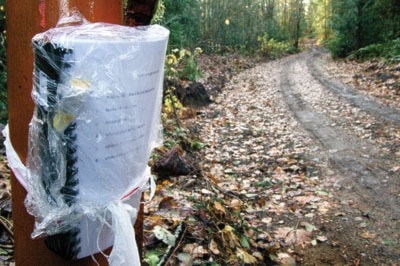The Nanoose First Nation has applied for an injunction to keep observers away from a controversial logging operation on Vancouver Island.
Addressed to people involved in protesting the logging of the land — known as District Lot 33 (DL33) off Morelo Road in Nanoose Bay — the injunction is scheduled to be heard in court today (Friday, Nov. 25) and could be granted as early as today.
Brent Edwards, a Nanoose councillor who oversees the band’s forestry portfolio, said the tenure in question is second-growth forest, and the band has made every effort to consider the environmental impact and the safety of the protesters.
“We were shut down the first and second day by protesters and we haven’t been able to get a full half-day in yet,” said Edwards. “The injunction is really for the safety of the people who are there in the forest during the logging process. We have to sort through self-proclaimed experts and our own experts, then take a look at the real big picture and the real big picture is we’re neighbours with these people and to move forward, we don’t want to put anybody in danger.”
Edwards added that the logging licence was not challenged in court and the band has met or exceeded all environmental regulations for the cut block, which will not be clear-cut.
Beginning Nov. 9, the Nanoose First Nation was approved by the province to log one-quarter of the 64-hectare parcel of Crown land.
That approval came despite protests from local communities, the Regional District of Nanaimo, and environmental groups like the Wilderness Committee, because the lot is home to a rare coastal Douglas fir forest and wetland ecosystems called a Douglas fir biogeoclimatic zone.
Annette Tanner, spokeswoman for the mid-Island chapter of the Wilderness Committee, said the First Nation has the right to log the area through its successful application, but blames the provincial government for allowing it to be logged in the first place.
“We’re hoping that the provincial government will reimburse the Nanoose First Nation monetarily for the cost they would have received from the property and start moving ahead very quickly to conserve whatever areas are still remaining, not only on Crown land but also on private land,” said Tanner.
Six per cent of coastal Douglas fir forests are on Crown land and only 110 hectares have been protected along the eastern part of Vancouver Island. Of that land, a small percentage is old-growth, including DL33.
Across B.C. the province controls about nine per cent of remaining coastal Douglas fir forests, about 23,500 hectares, and so far has protected 7,600 hectares. The ecosystem is not found in any other part of Canada.
The Wilderness Committee has worked to protect rare coastal Douglas fir forests since the mid-1990s, and worked for more than two years specifically to protect DL33, which sits in a UNESCO-designated biosphere reserve. It has sent observers daily to the logging sites to ensure no further damage is incurred to other trees or sensitive areas when big trees are cut down.
“We have people there watching,” said Tanner. “Both to ensure the Crown land and nearby private land aren’t damaged any further than they are already being damaged.”
